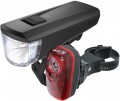The number of individual light emitting diodes (LED) installed in the flasher (see "Type").
A flasher does not require high brightness, so several LEDs are usually installed in such lights based on specific operating modes: for example, a pair of LEDs can flash alternately, several in a row provide the effect of “running lights”, etc. At the same time, one LED is enough for use for its main purpose.
The type and number of batteries used by the bike light.
All elements, except for the proprietary batteries (see below), are removable and, usually, quickly replaced; many of them are available in two versions — disposable batteries and rechargeable batteries. The advantage of batteries is their low cost, but they need to be bought regularly; batteries are noticeably more expensive, but once you buy a kit and a charger, you will no longer need to spend money on batteries.
—
AA. One of the most popular modern standard sizes. However, in bicycle lights, such elements are used infrequently — in particular, because of the relatively large size. There are many brands of AA batteries on the market, differing in capacity and, accordingly, operating time.
—
AAA. A smaller version of the AA battery described above. Due to their compact size, they are well suited for bicycle lights; and the capacity of such batteries, although rather low, is quite sufficient, taking into account the specifics of use (flashing lights most often do not have significant power consumption).
—
CR2032. One of the most popular and largest types of coin batteries, with a diameter of 20 mm and a thickness of 2.3 mm. At the same time, compared to cylindrical cells (like AA), the dimensions of such batteries are very compact, which, combined with good capacity sp
...ecs, makes them very convenient for flashing lights. Typically, CR2032 cells are sold as disposable batteries.
— CR1025. Another type of coin battery is 10 mm in diameter and 2.5 mm thick. Due to their smaller size, they are noticeably inferior to RS2032 in terms of capacity, which is why they are used very rarely — mainly in flashing lights of low brightness, created with an emphasis primarily on compactness.
— LR44. Coin batteries (usually disposable) with a diameter of 11.6 mm and a thickness of 5.4 mm. The features are similar to those described above CR1025 but they are even rarer.
— LR01. Also known as LR1 or N. They are produced mainly in the form of disposable batteries, they are cylindrical, 30.2 mm long, and 12 mm in diameter (thus, LR01 is shorter than AAA, but noticeably thicker). Such batteries are considered optimal for devices with high current consumption. However, such devices are relatively rare among bicycle lights, and therefore LR01 has not received much distribution.
— 18650. Elements are usually made in the form of lithium-ion rechargeable batteries. Similar in shape to the AA battery, but larger, with higher capacity, and a higher voltage of 3.7V. 18650 cells are designed for high-power devices; therefore, in the case of bicycle lights, such power is a sign of a high-end model, with very high brightness levels and a long battery life. There are few such models on the market.
— Proprietary rechargeable batteries. This category includes all proprietary batteries that do not belong to any of the standard sizes, and often non-removable ones. In the case of bicycle lights, the convenience of the battery lies in the fact that it is immediately supplied in the kit. On the other hand, such a battery in the event of a discharge cannot be quickly replaced with a new one. However, the battery life is usually quite decent, and this disadvantage can hardly be considered significant; with careful attention and regular charging, it is reduced to almost zero.The presence of
water protection can have an IP standard, which indicates the degree of protection against dust (first digit) and against moisture (second digit). Often the first digit may be omitted and changed to X (IPX6 instead of IP66), since water protection is the key parameter. Water protection is characterized by different numbers, where a larger value is considered more advanced. And the IPX7 models are completely capable of working under water for some time.

